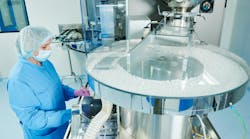The pharma industry is undergoing a period of major change as more companies shift their focus from mass producing generalized medications to finding innovative ways to deliver targeted therapies. With those changes comes the challenge of finding operational solutions for these new manufacturing methods.
In aseptic processing in particular, the need for a robust containment strategy is becoming increasingly complex — especially as companies work with small batches of new kinds of therapies.
“More companies [are] producing drugs that require containment, including cytotoxics, viral vectors and potent hormones,” Chris Procyshyn, chief executive officer of Vanrx Pharmasystems, says. “What these companies have in common is that the drugs are more targeted, creating the need for a higher number of small batches.”
Working with small batches of personalized medicines ups the ante in terms of risk. Companies not only have to worry about the economic fallout of contamination — they could also corrupt a sample from the patient, and may not get another one.
The rising demand for high potency active pharmaceutical ingredients (HPAPIs), which require specialized handling, is also putting new pressure on the supply chain to provide reliable containment solutions.
“Manufacturers are increasingly needing to adopt more innovative containment strategies to meet the more stringent requirements associated with high potency handling,” says Michael Avraam, the global product manager at ChargePoint Technology for the PharmaSafe range of products.
Here’s a look at some of the innovative solutions vendors are providing to solve new containment challenges.
Smarter Tech
As manufacturing becomes more complicated, the market for smart technologies to help simplify and execute operational processes is expected to flourish. More automated and wireless solutions are being developed as companies look for ways to integrate processes and boost efficiencies.
“The industry has already started to integrate wireless monitoring technology into its containment strategies as the demand for high potency drugs increases and the biotechnology sector continues to boom,” Avraam says. “For example, by incorporating wireless monitoring technology directly onto the valve installation, it provides operators with vital performance usage data as well as generating an easily accessible audit trail. This provides maintenance, health and safety and compliance teams with the necessary information to be able to make informed decisions to proactively manage their maintenance programs.”
As companies focus on working with smaller batches, they’re also looking for ways to decrease their plant-floor footprint (see our cover story on p. 12). In these smaller-scale production facilities, smart and compact solutions are often needed to replace space-stealing equipment. Static clean-in-place (CIP) systems, for example, often occupy a lot of precious floor place, an issue being addressed by mobile CIP systems.
“Mobile CIP is taken to the equipment when required and removed afterwards. There is no need for dedicated floor space, distribution pipework or additional routing control, as the CIP is adjacent to the item being cleaned,” says Dave Adams, systems director at Suncombe. “Mobile CIPs are typically developed to clean a number of items of equipment. These could be, for example, reactors, columns or vessels.”
Last year, Suncombe launched a new line of MobileCIP units that are designed to easily move to different operating or storage locations, operational parameters for recipes (times, temperatures, flow rates and detergent strength), and can be stored for both existing and future equipment.
According to Procyshyn, many of the current filling technologies are also not well-suited to the new manufacturing landscape that requires rapid batch changeover and containment on a smaller scale. To answer this issue, Vanrx has developed a gloveless robotic isolator.
“Gloveless isolators use robotics, nested ready-to-use components and single-use product contact materials to create safer aseptic processing operations,” he says. “By integrating these technologies and designing out the sources of interventions, the system can be completely closed, with no glove ports.
“Clean-in-place and viral inactivation through vapor-phase hydrogen peroxide (VHP) make the system safer for operators, and reduce the risk of cross-contamination,” Procyshyn continues. “From a containment perspective, gloveless isolators are helping pharmaceutical companies to reach their goal of safely and efficiently producing today’s targeted therapies.”
Seasonal Challenges
In addition to changes in the industry, changes in the weather can also trigger new problems in the manufacturing space. With the warmer weather, companies have to think about how they combat the growing risk of mold, which can spread quickly and be tough to remediate. Thus, early detection of mold is key.
Automating microbial quality control can help ensure that mold is caught and reported faster than traditional methods. More sensitive detection systems can also decrease the amount of time it takes for mold to be found.
“Rapid detection allows facilities to both detect the contamination earlier and once cleaning has been completed, ensure facilities that their contamination has been eradicated by returning final results days faster than the traditional method,” says Wendy Hinchey, vice president of Global Sales, Marketing and Product Management at Rapid Micro Biosystems. “Rapid detection and automation provide real-time actionable data allowing companies to increase operational efficiency while safeguarding patient safety.”
As industry and patient needs evolve, equipment manufacturers are stepping up and helping pharma companies meet new contamination challenges.
[javascriptSnippet]





